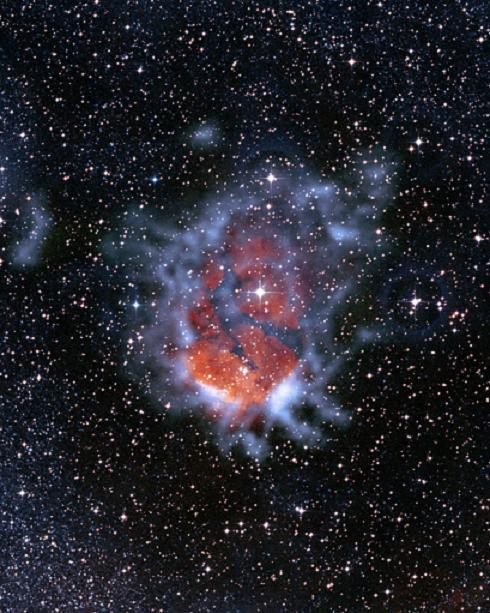
home •
about •
essential guide •
picture of the day •
thunderblogs •
news •
multimedia •
predictions •
products •
get involved •
contact
picture of the day archive subject index
Ionized star-forming region RCW120. Credit: ESO/APEX/DSS2/SuperCosmos
Nov 19, 2008
So Hot You're Cool, So Cool You're Hot
Clouds of ionized gas and dust in space are not heated up by gravity, they are compressed by electrical forces and emit synchrotron radiation.A recent press release from the European Southern Observatory explains that this image shows “an expanding bubble of ionized gas,” shown here in red. The bubble is assumed to be generated by the ultraviolet radiation from a central star. It has caused a “shock wave” that “sweeps up a layer of the surrounding cold interstellar gas and cosmic dust. This layer becomes unstable and collapses under its own gravity into dense clumps…, where new stars are born.” The gas and dust has a temperature only 23 degrees above absolute zero (23K). This temperature is determined by the submillimeter wavelengths of the radiation, shown here in blue, and the assumption that the radiation is produced by thermal processes.
Anyone who is familiar with plasma will immediately recognize that “if it’s ionized, it ain’t gas.” And if it ain’t gas, a shock wave is not likely to trigger gravitational instability and collapse. The filaments and knots indicate the “pinch” activity of the much greater electromagnetic forces of Birkeland currents.
The roughly concentric and radial filaments prompt one to suspect that we are looking “down the barrel” of an interstellar Birkeland “cable,” which is pinching down in an hourglass form to create and to power the central star. The instabilities are not those of gravitation, which have never been shown convincingly to cause collapse. They are plasma instabilities, which have been shown in lab demonstrations not only to pull in material and to compress it but also to set it spinning. (Removing and imparting spin at exactly the right times in exactly the right amounts is an insurmountable obstacle in theories of gravitational collapse.)
From a plasma perspective, the temperature is also open to question. Consensus astronomy talks a lot about unobservable things like dark matter and dark energy, but it talks hardly at all about observable synchrotron radiation, which is what most celestial radiation is. Thermal radiation is produced by random collisions of atoms, and its “peak” wavelength is a measure of the temperature of the atoms. Synchrotron radiation is produced by electrons moving along a magnetic field.
Moving electrons are also known as an electric current, and a current moving along a magnetic field—a “field-aligned current”—is also known as a Birkeland current. It’s therefore not surprising that a universe composed almost exclusively of plasma, which organizes itself into Birkeland currents, should principally emit synchrotron radiation. Of course, synchrotron radiation gives no indication of temperature: indeed, since it comes from a non-random process, “temperature” is not even defined.
By Mel Acheson
___________________________________________________________________________Please visit our Forum
The Electric Sky and The Electric Universe available now!

|
|

|
EXECUTIVE EDITORS:
David Talbott, Wallace Thornhill
MANAGING EDITORS:
Steve Smith, Mel Acheson
CONTRIBUTING EDITORS: Michael Armstrong, Dwardu Cardona,
Ev Cochrane,
C.J. Ransom, Don Scott, Rens van der Sluijs, Ian Tresman
WEBMASTER: Brian Talbott
Copyright 2008: thunderbolts.info
![]()
home •
thunderblogs •
forum •
picture of the day •
resources •
team •
updates •
contact us

